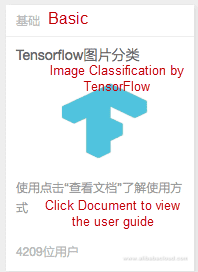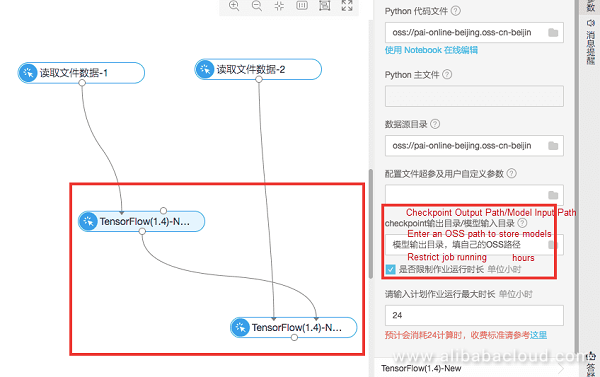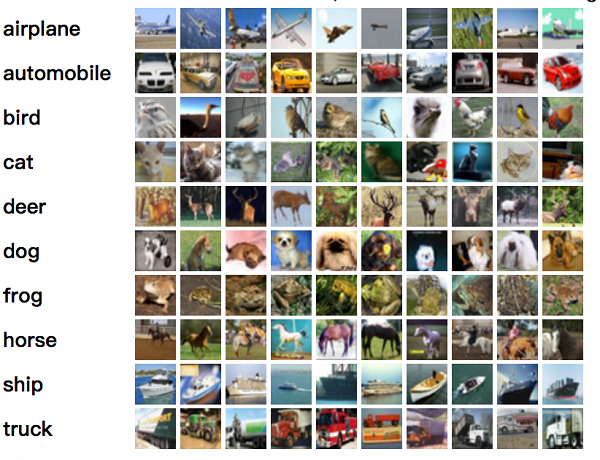Effectively making use of unstructured data from large amounts of image and voice data has always been a challenge for data mining professionals. The processing of unstructured data usually involves the use of deep learning algorithms and these algorithms can be daunting for beginners. In addition, processing unstructured data usually requires powerful GPUs and a large amount of computing resources. This article introduces a method of image recognition using deep learning. This method can be applied to scenarios such as illicit image filtering, and object detection.
This experiment creates an image recognition model using the deep learning framework TensorFlow in Alibaba Cloud Machine Learning Platform for AI. The entire procedure takes about 30 minutes to complete. After the model training process, the system is able to recognize the bird in the following image, and return the word "bird":

This experiment can be created from the following TensorFlow image classification template:

If you choose to create the experiment from the template, replace the checkpoint path in both the parent and child TensorFlow components with your OSS paths and then run the experiment, as shown in the following figure:

You can refer to Image Classification with TensorFlow and get more skills.
This article introduces Caffe deep learning framework to perform complete image classification model training on Alibaba Cloud's Machine Learning Platform for AI.
The Image classification by Tensorflow section introduces how to use the TensorFlow framework of deep learning to classify CIFAR-10 images. This section introduces another deep learning framework: Caffe. With Caffe, you can complete image classification model training by editing configuration files.
Make sure that you have already read the Deep Learning section and activated deep learning in Alibaba Cloud Machine Learning Platform for AI (PAI).
This experiment uses a CIFAR-10 open-source dataset, containing 60,000 images with pixel dimensions 32 x 32. These images are classified into 10 categories: airplanes, automobiles, birds, cats, deer. dogs, frogs, horses, ships, and trucks. The following figure shows the dataset.

The dataset has already been stored in the public dataset in Alibaba Cloud Machine Learning Platform for AI in JPG format. Machine learning users can directly enter the following paths in the Data Source Path field of deep learning components:
In this article, we discuss how image search technology can be applied to the retail industry in the form of mobile virtual assistant and targeted campaigns.
The rise of artificial intelligence (AI) and big data technologies have helped fuel innovations in the retail industry. Cutting-edge products, including Alibaba Cloud's Image Search and Machine Learning Platform for AI, have transformed the way customers interact with and shop for products. Customers no longer need to queue up in brick and mortar stores; they can also conveniently search for products by performing a quick image search.
However, the usage of image search technology is not limited to a simple product search on e-commerce platforms in the retail industry. In recent years, we have witnessed an increasing number of initiatives to provide new customer experience through the integration of simple image search service. This includes using image search for stock keeping unit (SKU) search as well as for matching products with source materials and or patterns.
This article shows how image search technology can be used in different areas other than e-commerce platform product search.
An innovative application of image search technology in the retail industry is the development of mobile virtual assistants. This solution is intended to help customers to choose the right product with virtual assistance, reducing labor costs as well as optimizing stock keeping.
There is always an issue to promote new products in reseller shops. For example, the shops may not have enough assistants, the shop assistants may not have the latest product information, or they are not familiar to all items in the product line. Furthermore, products with similar packaging makes it challenging for customers and shop assistants to determine the right item.
These problems can be easily solved by simple app integrating with image search service. For example, we can provide a virtual assistance through a membership application or QR code. Through the application, the customer can take a picture of the product to retrieve product information including product features, pricing, comparison, as well as guidelines to choose the right items.
If customers have more questions, we can integrate online customer services (such as a chatbot or service center) to support the customers by providing personalized services. This flow can easily link to other follow up promotions such as coupon or product recommendations. Additionally, this approach can be one of the channels for O2O integration by allowing customers to purchase from online shops.
Image recognition is a popular technology that can detect, understand, and distinguish images from one another.
Image recognition is a popular technology that can detect, understand, and distinguish images from one another.
Understanding the way we perceive objects and images has always been a hot topic for research. Researchers globally have observed that the human eye is very sensitive to the edges of an object. Typically, a person identifies an object by first determining the outline of the object and then processing this information in the visual cortex. Computer scientists have designed sophisticated image recognition systems by emulating the way we recognize images.
The example below is based on a paper by Adit Deshpande, a student at The University of California, titled A Beginner's Guide To Understanding Convolutional Neural Networks. In this paper, he introduces a simple algorithm as the basis of image recognition.
How to deploy an image process service on Alibaba Cloud without even using a server (server-less architecture)? Through this Clouder lesson, you will learn how to conveniently do it with Alibaba Cloud Function Compute.
This course is designed to assist users who want to get knowledge of serverless computing technology, and who like to use cloud product to apply data processing. In this course, users can understand what is serverless compute, the advantage of function compute, and can apply function compute to satisfy simple business demands.
Websoft9 Joomla is a pre-configured, ready to run image for running Joomla on Alibaba Cloud.Joomla! is an award-winning content management system (CMS), which enables you to build websites and powerful online applications.
This image is built with Ubuntu16.04 64bit and bundled with following popular software for web service solution. It includes ready-to-run versions of Apache, MySQL, PHP and phpMyAdmin and all of the other software required to run each of those components. Optimized to add your security concern.
Image Processing (IMG) is a massive, secure, cost-effective and highly reliable image processing service. After source images are uploaded to OSS, you can process images on any Internet device at any anytime, from anywhere through simple RESTful APIs.
For more information about IMG, see Image Processing.
For the complete code of IMG, see GitHub.
IMG uses standard HTTP GET. You can configure IMG parameters in QueryString of a URL.
If the ACL of an image object is private read and write, only authorized users are allowed for access.
In Image Service, URLs are accessed with standard HTTP GET requests, and all processing parameters are in the QueyString of the URL.
Request for thumbnails through processing parameters
If you want to have a source image processed and then returned, the following two formats are available:
Access through a third-level domain name: http://bucket./object?x-oss-process=image/action,parame_value
Multiple actions are executed in sequence. For example, image/resize,w_200/rotate,90 has the effect of scaling down an image to 200 in width and then rotating the image 90 degrees.
An encrypted and secure cloud storage service that can store, process, and access massive amounts of data from anywhere in the world
An intelligent image search service with product search and generic search features to help users resolve image search requests.
Definition and Benefits of Message Queuing Notification Service

2,605 posts | 747 followers
FollowAlibaba Clouder - February 1, 2021
Maya Enda - June 16, 2023
Alibaba Clouder - June 29, 2020
Rupal_Click2Cloud - June 14, 2022
Alibaba Clouder - May 18, 2021
Amuthan Nallathambi - June 4, 2023

2,605 posts | 747 followers
Follow ApsaraVideo Media Processing
ApsaraVideo Media Processing
Transcode multimedia data into media files in various resolutions, bitrates, and formats that are suitable for playback on PCs, TVs, and mobile devices.
Learn More CT Image Analytics Solution
CT Image Analytics Solution
This technology can assist realizing quantitative analysis, speeding up CT image analytics, avoiding errors caused by fatigue and adjusting treatment plans in time.
Learn MoreMore Posts by Alibaba Clouder